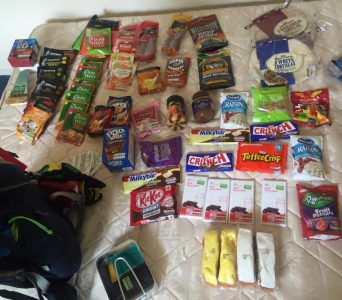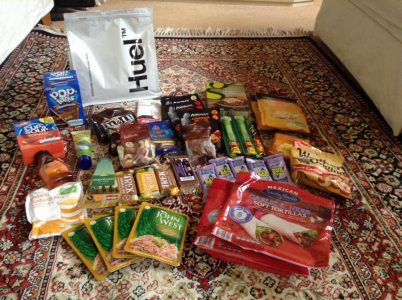This list was originally compiled for the 2017 summer expedition to Georgia by Cat Easdon, but has been passed down through the years, and may be useful for planning your own backpacking trip.
Individual Kit
- Travel Documents and Money
- Passport
- Travel insurance documents
- Flight confirmations
- UK train/bus tickets
- Money
- Starling uses the MasterCard base rate for cash and purchases, no international fees
- ID, Student ID?
Equipment
- Walking poles (optional)
- Rucksack (~60-70L – big enough for all your gear and food)
- Waterproof rucksack cover
- Dry bags or something else to keep your stuff dry e.g. plastic bags/bin liners. You can never have too many bin liners, they’re very handy for rubbish.
- Water bottles/water bladder, ~2-3L
- Water purification tablets or a water filter if you already have one/are keen to buy one (the Sawyer Mini is fab and means your water will actually taste like water, yay, but bear in mind you’ll need to do a fair bit of pumping)
- Sleeping bag – keep in mind night temperatures at altitude are much lower than in the valley. A liner can really help add warmth as well
- Roll mat/inflatable mat
- Stuff for emergency repairs (handy to have some duct tape, a few safety pins, spare shoe laces, carabiners etc. Check the contents of James’ pockets for ideas :P)
- Penknife
- Head torch
- Mug (could use a pan)
- Something to cook with and eat out of (e.g. mess tin or similar)
- Cutlery/spork
- Small personal first aid kit
- Antiseptic/Germolene
- ALLLLL THE PLASTERS. You would not believe how many plasters you can get through with cuts/blisters
- Personal medication as needed (see notes above)
- Ibuprofen/paracetamol (see notes above)
- A few Imodium tablets + some rehydration sachets are v v v useful in case you have any stomach issues
- Anything else you want to bring
- Glasses/contact lenses if you need them
- Survival bag
- Whistle
- Phone, charger and plug adapter (check destination).
Clothing
- Walking Boots
- Lightweight spare shoes/sandals/flip-flops for evenings.
- Gaiters (Mountain Warehouse sell cheap ones) – recommended not compulsory
- Waterproof jacket and trousers
- Walking trousers x2
- Base layers
- Fleeces/warm clothes (synthetic is better than cotton and several layers work better than one thick one – 2 fleeces that you can layer would be ideal. Bring a packable down/belay jacket if you have one)
- Thick walking socks (bring spare pairs – expect to get wet feet)
- Underwear
- Woolly hat
- Sun hat
- Gloves
- Buff
- Sunglasses
- Eye mask (if being woken up at 5am by the sun bothers you!)
If you haven’t done much backpacking before and aren’t sure how much clothes to take, my advice would be that you need fewer changes of clothes than you need (e.g. you could definitely get away with just 2 base layers), but you do need at least one spare set of clothes so you have something dry to put on if you get soaked. Don’t worry about stinking – it’s inevitable. If it’s nice weather you can do some washing!
Toiletries
- Toothbrush and toothpaste
- Deodorant
- Lightweight travel towel
- Lipsalve, hand cream
- Sun cream
- Soap/shampoo
- Hand sanitiser
- Wet wipes
- Toilet roll
- Sponge/rag to scrub your pan with
- Insect repellent
Climbing/scrambling gear (if applicable)
- Helmet
- Climbing gloves
- Shoes
- Harness, rack where applicable
- Chalk?
Optional
- Camera (plus batteries/charger)
- Portable battery pack, solar charger (if you have them)
- Packable bag for day walks
- Flint and steel/lighter (note if you bring a lighter, it must go in your carry-on, not your checked luggage – I know this is bizarre – in a clear plastic bag like you use for liquids). Probably easier to just buy one there.
Group Kit
- Tents
- Stoves
- Group first aid kit
- Group shelters
- Trowel
Food
Written by Cat Easdon, 2017
As for the first week’s food – If you’ve backpacked before, you know the drill. You want a good calorie to weight ratio (ideally 400+ kcal/100g), some protein and fat (don’t try and live entirely off sugar – chocolate, cake and sweets are fab for motivation but also keep you on a rollercoaster ride of sugar highs and sugar crashes if that’s all you’re eating), and most importantly you want food that you like. Nothing worse than finishing a tough day and only having something rubbish for dinner :’( Couscous + cup a soup + chorizo or tuna sachets always works a treat for dinner, and beanfeast is a decent protein option if you’re veggie. I’m pretty keen on ‘shepherds pie a la UBESter’ which is cheesy instant mash + freeze-dried soya mince (you can get packets which include veggies). Avoid microwave pasta snack meals which need to simmer for ages – go for stuff which just needs boiling water added to it. Ideally, you want breakfasts that don’t require hot water to save on gas/time, although if it’s cold we’ll probably want tea anyway so that isn’t too much of a problem. For during the day you want plenty of snacks to keep you going – things that are quick to eat and don’t require any preparation. Tortilla wraps are the standard go-to for lunch. Milk powder can be fab for tea/morning muesli and you can find it in most big supermarkets. Obviously remember you have to carry all this so don’t go crazy, but I always find on backpacking trips that I am so much hungrier than I thought I’d be – a backpacking trip is really not the time to try and go on a diet :L
If you want some ideas, here’s what George and I each brought to Lofoten in 2016 (~9 days’ food). No prizes for guessing that the Huel one is mine! I’d try and aim for somewhere in between these two – George had a bit too much sugary stuff, I had too little (and just too little food in general – I ended up buying some of George’s food off him mid-trek…). The Trek bars were abysmal, but the cheapo protein bars from Poundland (in purple) were actually pretty good. Universal consensus on parmesan and chorizo was: 10/10, would bring again. Huge motivation boost and fab source of calories.


Also, a few years back Tom Hill made a pretty handy spreadsheet comparing nutritional info for some common supermarket items: https://drive.google.com/file/d/0BzD5i6PbDCSYanlENTlHeklBUjA/view?usp=sharing


You must be logged in to post a comment.